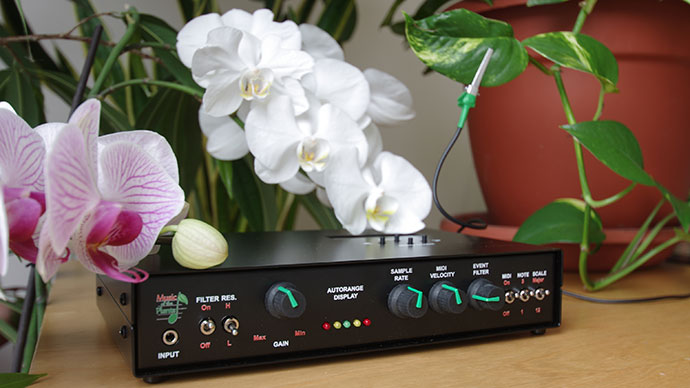What Music-Playing Plants Can Teach Us About Consciousness
The Music of the Plants project, created by a spiritual eco-community, investigates how humans can live more consciously and harmoniously with the natural environment.
Monica Uszerowicz
When Cleve Backster — interrogation specialist for the CIA and a purveyor of the polygraph — hooked his lie detector machine to a dracaena plant in 1966, he made a curious discovery: plants could sense things. After trying to measure the rate at which liquid rose in his dracaena, he thought that burning one of its leaves might induce another reaction altogether. But the dracaena began to “react” before he could even attempt it, sending the polygraph into a chart reading of high intensity (anxiety, as it’d be interpreted in a human subject) — it seemed the plant knew he’d intended to hurt it. Backster concluded that plants had “primary perception,” an ability to perceive what the bodies closest to them were feeling. They were, in a word, conscious.
During a small lecture at a private residence in Delray Beach earlier this month, I watched a houseplant play music, unabashedly and beautifully. Potted and still, it was hooked up to a MIDI machine via electrodes, its bio-emissions creating twinkling melodies. Attached to the same machine, an orchid and rosemary plant played nothing, but this one was active and virtuosic, as though it enjoyed playing.
The MIDI machine is part of a project called Music of the Plants, developed in the 1970s by researchers at Damanhur, a spiritual eco-community in Piedmont, Italy. Damanhur’s primary tenet is that the natural environment is conscious, and meant to exist in cohabitation with humans; in 2005, the community received recognition from the United Nation’s Global Forum on Human Settlements as a model for a sustainable society. While plant music has been created before —Mileece, a sonic artist, makes plant symphonies using similar technology — the Music of the Plants is essentially Damanhurian. It’s as much about art as it is about plant sentience and intelligence, which is its own field of study.
The Delray talk was led by Tigrilla Gardenia (Damanhur’s naming ceremony asks residents to choose an animal and plant), an ambassador and researcher at Damanhur who’s helped bring the Music of the Plants everywhere, from orchestral concerts in Tuscany to small shows in Brooklyn. Though Tigrilla is conducting research into the healing benefits of plant music — at addiction treatment centers, for example — the instrument is most popular among, unsurprisingly, musicians. They connect it to their plants and play along; because it depends entirely on the individual plant’s bio-emissions, there’s no predictability (the same thing would happen if you hooked electrodes to your own body). It may take coaxing, or time, or playing another instrument beside it to get it going. Suddenly recognizing the potential decision-making properties of plants, you’re reminded how much like pets they truly are. (You can even purchase a machine yourself — but it’ll cost you hundreds.)
As Tigrilla explained in an e-mail to Hyperallergic, prior to the lecture: “The Music of the Plants is based on a biofeedback system … it is a system that measures the bio frequency of the plants or trees and transfers it through a midi synthesizer, so that it is possible to hear the plants or trees and the variations of their frequency. The instrument consists in the perception of electromagnetic variations. This is, in practice, a pulse converter that registers, through two sensors, the flow of root-leaf lymph. The mechanism is comparable to an electrocardiogram for a human being.”
Following Backster’s findings, plant intelligence studies range from widely-documented research to more makeshift experiments —some of which took place at Damanhur during its early years. The bio-emissions of houseplants were tested at Damanhur for their ability to turn on lightbulbs and open doors. The plants consistently responded positively only to people who’d watered or touched them; for everyone else, doors remained closed.

The point in all this research, for Damanhur, is symbiosis. “We’re not hippies,” Tigrilla insisted, espousing little fetishization of nature itself and no calls to return to a more “primal” way of living. Instead, she said, “The truth is, cities can be the most sustainable way of living for most people … So why, then, do we build them so disconnected to what naturally makes us feel good, like public green spaces, local food production straight from the garden, and integrated plant life?” (Her #natureinthecity movement promotes more urban integration with the plant world.)
But can plants heal? Says Tigrilla, “Modern science is showing us that just the mere presence of a plant in a room … can accelerate the recovery time in a hospital. Studies into the effects of more plant life in cities shows decreased depression and crime rates … Add to that the research into the healing properties of music, and you have a winning combination.” Imagine watering a plant that, in turn, sings for you — I imagine it’d be akin to hugging your dog. Maybe it’s not so much that they are sentient. Perhaps, instead, they make us more conscious of ourselves.
For future Damanhur and Music of the Plants programming this fall and winter, view their Facebook event page here.
